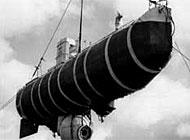The Highs and Lows of the Piccard family

The Lake Geneva Museum in Nyon is inviting visitors to take a trip up to the heights of the stratosphere and down to the depths of the deepest ocean with the Piccards, Switzerland's most intrepid family of adventurers.
Bertrand Piccard, who two years ago became the first man – along with Britain’s Brian Jones – to fly non-stop around the world in a balloon, needs little introduction. But he is the third generation of Piccards to have been a record-breaking adventurer.
His grand-father, Auguste, was the first person to fly up to the stratosphere, while his father, Jacques, became the first man to explore the deepest point on Earth, at the bottom of the Pacific Ocean.
“Through their hard work and unquenchable faith in fundamental principles, these men have allowed us to discover the Earth’s extraordinary – but extraordinarily fragile – heritage,” says the museum’s curator, Jean-François Rubin.
“More importantly, they’ve allowed us to dream,” he adds.
In 1999, the same year as Bertrand was flying around the planet, Jacques Piccard donated all his personal archives to the Lake Geneva Museum. The rich scientific and personal details they provided made the exhibition, entitled “From Space to the Abyss – the Piccard Family between Sky and Sea”, possible.
Auguste Piccard, a physics professor, wanted to study cosmic rays, which required him to enter the stratosphere. This he achieved in 1932, when he took his balloon, the FRNS, to an altitude of 16,000 metres, the first person to attain such heights.
Using the same principal – an enclosed capsule attached to a float – he built the bathyscaphe FRNS 2, with which he intended to explore the deepest reaches of the oceans. Although it reached a depth of 1,380 metres, the experience was only a partial success, and in 1952, with the help of his son, Jacques, Auguest Piccard, built the Trieste.
This vessel smashed all the existing records for deep-sea exploration, first in the Mediterranean, and later in the Pacific. The US navy, quick to see the potential of the Trieste, bought it in 1958.
Two years later, Jacques Piccard and the American naval officer, Don Walsh, plunged to the bottom of the 11,000 metre-deep Mariana Trench, the deepest point on Earth. No submarine in operation today is capable of replicating this feat.
Featured in the exhibition is the hatch of the Trieste, which Jacques Piccard “stole” from the vessel while it was on display in a museum in Washington. Alongside is the Rolex divers’ watch that Jacques Piccard wore on the record-breaking mission. The timepiece easily withstood the immense pressure of being at 11,000 metres, which is more than could be said for any diver who dared to venture that deep.
Jacques Piccard went on to build three more important submarines. The first, named after his father, was the star attraction at the Swiss National Exhibition in Lausanne in 1964. Billed as the first ever tourist submarine, the Auguste Piccard took 33,000 people to the depths of Lake Geneva.
That vessel was followed by the Ben Franklin, built at the request of Nasa to get its Apollo astronauts accustomed to confined spaces and to conduct scientific experiments in the Gulf Stream. Finally, in 1978, Jacques built the F.A.-Forel, a small submarine, which is still used to conduct scientific experiments in European lakes and the Mediterranean.
With his 478-hour balloon trip, Bertrand demonstrated that it is impossible to say that the Piccards’ lust for adventure is over. There are no fewer than eight children in the Piccard clan. The chances are that at least one of them will venture where no person has gone before.
From the FRNS to the Breitling Orbiter, the Lake Geneva Museum contains a family’s insatiable quest for discovery. You have until March 2002 to enjoy it.
by Roy Probert

In compliance with the JTI standards
More: SWI swissinfo.ch certified by the Journalism Trust Initiative
You can find an overview of ongoing debates with our journalists here. Please join us!
If you want to start a conversation about a topic raised in this article or want to report factual errors, email us at english@swissinfo.ch.